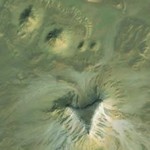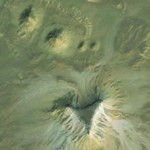 Two unidentified, possible pyramid complexes have been located with satellite imagery from Google Earth.
Two unidentified, possible pyramid complexes have been located with satellite imagery from Google Earth.
One of the complex sites contains a distinct, four-sided, truncated, pyramidal shape that is approximately 140 feet in width. This site contains three smaller mounds in a very clear formation, similar to the diagonal alignment of the Giza Plateau pyramids.
The second possible site contains four mounds with a larger, triangular-shaped plateau. The two larger mounds at this site are approximately 250 feet in width, with two smaller mounds approximately 100 feet in width. This site complex is arranged in a very clear formation with the large plateau, or butte, nearby in a triangular shape with a width of approximately 600 feet.
The sites have been documented and discovered by satellite archaeology researcher Angela Micol of Maiden, North Carolina. Angela has been conducting satellite archaeology research for over ten years, searching for ancient sites from space using Google Earth. Angela is a UNC Charlotte alumnus and has studied archaeology since childhood. Google Earth has allowed her to document many possible archaeological sites, including a potential underwater city off the coast of the Yucatan peninsula that has sparked the interest of scientists, researchers and archaeologists. Angela is also a board member of the APEX Institute, founded by archaeologist William Donato, who is pioneering underwater archaeological research in the Bahamas. Angela has been assisted by Don J. Long, fellow APEX researcher and colleague.
The sites have been verified as undiscovered by Egyptologist and pyramid expert Nabil Selim. Nabil’s discoveries include the pyramid called Sinki at Abydos and the Dry Moat surrounding the Step pyramid Complex at Saqqara. Nabil has stated the smaller 100 foot “mounds”, at one of the proposed complex sites, are a similar size as the 13th Dynasty Egyptian pyramids, if a square base can be discovered.
Source: Archeology News

![new-pyramids-found[1]](https://coolinterestingnews.com/wp-content/uploads/2012/08/new-pyramids-found1.jpg)














